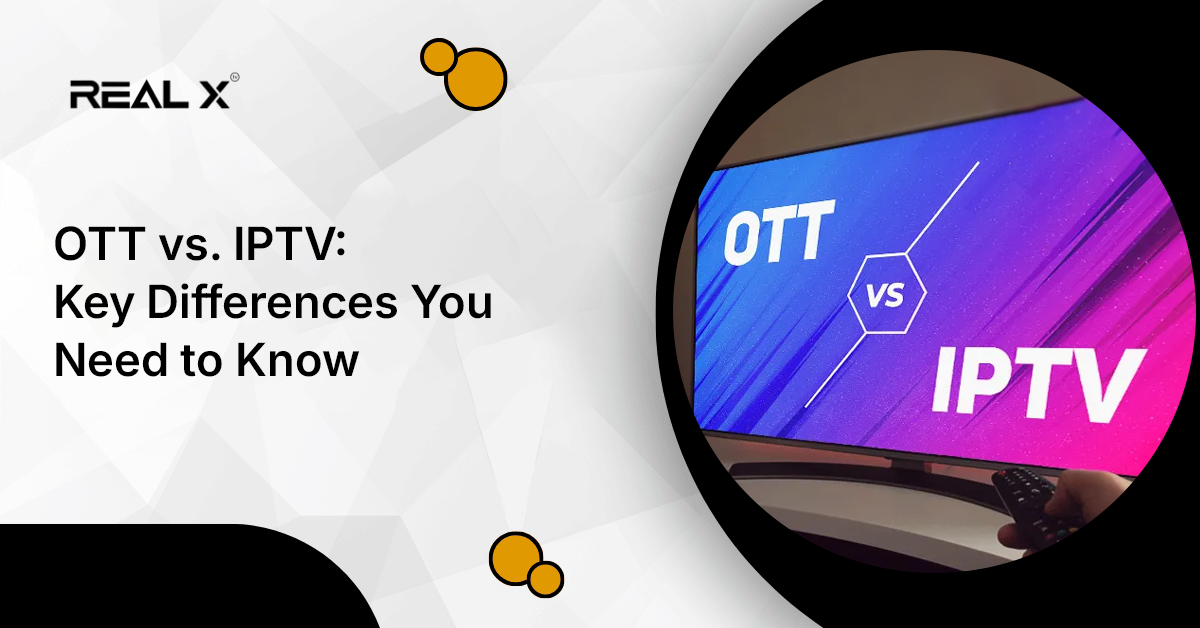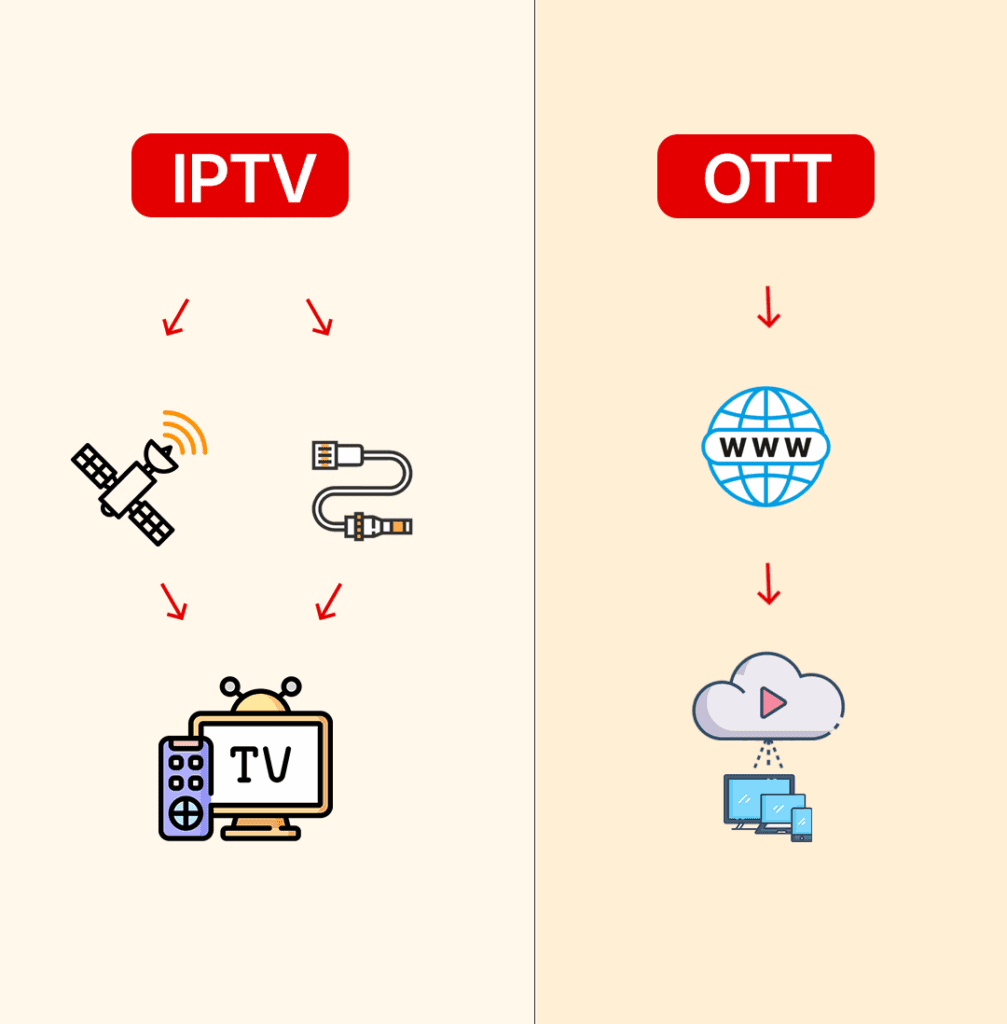Television entertainment has evolved tremendously from cable boxes and satellite television. In today’s television world, two terms are often heard: OTT and IPTV. At a basic level, both OTT and IPTV offer content to users over the Internet so it can be easy to misunderstand and think they are the same. However, OTT and IPTV actually have distinctions in terms of the technology, user experience and delivery mechanisms involved.
If you have been wondering which one is right for you or simply what makes them different – this blog will explain everything you need to know.
What is OTT?
OTT refers to any video content delivered through the internet without traditional cable or satellite TV. These services bypass the middleman, allowing you to access content directly on your device using your existing broadband connection.
Popular Examples of OTT Platforms
- Netflix
- Amazon Prime Video
- Disney + Hotstar
Key Features of OTT
- Works on the open internet
- Accessible on almost any device like Smart TVs, smartphones, tablets, laptops and even gaming consoles.
- Focuses heavily on on-demand streaming like movies, TV shows, original series and sometimes live TV.
OTT platforms have gained massive popularity because of their convenience and flexibility. You don’t need any extra hardware or installation, just an internet connection and a compatible device.
What is IPTV?
IPTV or Internet Protocol Television, delivers content through a managed private network. Instead of using open internet like OTT, IPTV relies on infrastructure controlled by an internet Service Provider (ISP) or telecom operator. This ensures a more controlled environment, resulting in better stability and consistent streaming quality.
Typical IPTV Services Include
- Live TV Channels
- Video on Demand
- Catch Up TV
- Interactive features like Pay Per View
Key Features of IPTV
- Delivered via a private network with dedicated bandwidth.
- Usually requires a set top box or operator provided app.
- Offers high quality streaming with minimal buffering.
- Often comes as part of bundled packages (TV + Internet + Phone)
IPTV is widely used by telecom operators and cable companies that want to provide digital TV services with better quality and additional interactive features.
OTT vs. IPTV: Key Differences You Need to Know
Although OTT and IPTV share a common principle they differ in several important ways.
- Delivery Method
This is the most significant difference.
- OTT uses the public internet means it shares bandwidth with all other online activities on your connection.
- IPTV operates on a managed network provided by your ISP. This ensures that TV traffic has priority, resulting in smoother playback.
2. Quality and Reliability
OTT services depend entirely on your internet speed. If your connection slows down, you will experience buffering or a drop in video resolution. IPTV, on the other hand, uses Quality of Service mechanisms to guarantee a stable and high quality viewing experience.
3. Device Compatibility
OTT is incredibly versatile. You can stream it on any internet enabled device – Smart TVs, smartphones, tablets, laptops. IPTV generally requires provider specific hardware, such as a set top box or a dedicated app tied to the service.
4. Content Model
OTT platforms are known for on demand content and exclusive originals. Think Netflix’s original series or Amazon Prime’s movies. IPTV, on the other hand, is built for live TV, though most IPTV services also include VOD and Catch up features.
5. Cost and Accessibility
OTT services are available worldwide. You can subscribe and cancel anytime, making them highly flexible. IPTV is usually tied to the operator’s coverage area and may require a long term contract often bundled with other services like internet and phone.
Why Does the Difference Matter?
The choice between OTT and IPTV depends on your viewing habits and priorities:
- Prefer flexibility and mobility? Go for OTT. You can watch your favorite shows on any device, anywhere, anytime.
- Want Guaranteed Quality for Live Sports and news? IPTV wins because of its managed network and bandwidth control.
- Hate extra hardware? OTT is better since you only need an app and internet connection.
- Love interactive TV features like PPV or DVR? IPTV services typically offer these extras.
OTT and IPTV Streams: How They Work
Both OTT and IPTV use internet technologies but the technical approach differs significantly.
 OTT Streams
OTT Streams
OTT platforms use HTTP based protocols like HLS (HTTP Live Streaming) and MPEG-DASH. Content is divided into small segments and delivered via Content Delivery Networks. The video quality adapts dynamically based on your bandwidth using adaptive bitrate streaming.
IPTV Streams
IPTV services use multicast or unicast delivery methods. They employ protocols like RTP and RTSP to maintain consistent performance and low latency.
Real World Examples
- If you are watching Netflix on your phone while travelling, that’s OTT.
- If you are using your telecom provider’s set top box to watch live sports at home then that’s IPTV.
Both have their advantages. OTT provides freedom and portability while IPTV ensures stability and reliability.
SHOP REAL TV BOX TO UPGRADE VIEWING EXPERIENCE!
The Future of OTT and IPTV
The gap between OTT and IPTV is narrowing. Many IPTV operators now offer OTT apps for customers, and OTT platforms like Amazon Prime Video and Disney+ have started streaming live events and sports. Hybrid solutions are on the rise, blending IPTV’s stability with OTT’s flexibility — shaping the future of IPTV.
In the coming years, we can expect:
- More OTT platforms offering live TV to attract traditional TV viewers.
- IPTV providers expanding into OTT for global reach.
- Integration with smart home and IoT devices for personalized experiences.
Final thoughts
Over-the-top (OTT) content can be offered over the same IP network that provides email and web traffic without the requirement for a dedicated set-top box. You experience OTT on multiple devices, including smartphones and tablets and even smart TVs – through an app or website. While OTT has restrictions on the availability of content in different locations, IPTV does not and it is more affordable.



